The Imperator Alexandr II class were two pre-dreadnought battleships built for the Imperial Russian Navy in 1885-91 to counter other armored ships of Baltic powers such as Sweden and Germany. Construction was very slow, making them obsolescent when completed as “turret ships”optimized for ramming, tactics that were now no longer in favor. Imperator Aleksandr II served in the Baltic and Mediterranean Seas and became a gunnery training ship in 1904, inactive in World War I and captured by the Bolsheviks in 1917, sold for scrap in 1922. Imperator Nikolai I als served in the Baltic and Mediterranean Seas, Pacific Ocean as observer during the First Sino-Japanese War and actor in the Russo-Japanese War. She surrendered after the Battle of Tsushima, recommissioned in the Imperial Japanese Navy and sunk as target in 1915.

Imperator Alxander II colorized by Irootoko Jr.
Development
The Imperator Aleksandr II-class battleships were essentially the first all-steel battleships built for the Baltic Fleet. Their purpose was to dominate the Baltic Sea the Swedish Helgoland and German 1877 Sachsen-class ironclads, protected by wrought iron. The Imperator Aleksandr II-class followed latest tactical theories which emphasized ramming, with a massive ram bow. They had a peculiar forecastle which deck sloped slightly downwards in order for the main guns to fire at the waterline at short range just before ramming. The hope was that the hits could open a breech in which the same could go through and cut their opponent in half.
To absorb punishment, engineers gave her a full transverse armored bulkhead forward protecting also the 9 in (229 mm) guns from raking fire and originally originally no side armor at all. In fact both battleships only had main guns forward, a single pair in a covered barbette. They also originally had a full sailing rig for long deployments to the Mediterranean or even to the pacific, albeit it was never installed on the end. Imperator Nikolai I was originally made into a completely different design, until changed as a modified version of the Imperator Aleksandr II but still with significant differences between them. Both were pretty extreme designs dictated by a narrow doctrine, and not very useful in the 1890s, more so after 1900.
Imperator Aleksandr II, named after the Emperor Alexander II was ordered to the New Admiralty Yard at Saint Petersburg. She was laid down on 12 July 1885, launched on 13 July 1887, completed in June 1891, with trials lasting until the spring of 1892. Imperator Nikolai I named after the Emperor Nicholas I was built by the Franco-Russian Works at Saint Petersburg, laid down on 20 March 1886, launched on 1 June 1889 and completed in July 1891 with trials lasting almost a until the summer of 1892.
Design of the class
Hull and general design
The Imperator Aleksandr II class reached 334 feet (102 m) long at the waterline (wl) for 346 feet 6 inches (105.61 m) overall, longer due to the ram. Her generous beam was 66 ft 11 in (20.40 m) making for a 1/5 ratio, and a generous draft of 25 feet 9 inches (7.85 m) perhaps not well suited for the shallow waters of the Baltic. She displaced unlike her sister 9,244 long tons (9,392 t) at full load, which over 800 long tons (813 t) more than her designed displacement (8,440 long tons) and caracteristic of Russian capital ships built at the time. Imperator Nikolai I had the same dimensions except in draft at 24 feet 3 inches (7.39 m) but she was 250 long tons (254 t) heavier.
Their hull was subdivided by a centerline, longitudinal bulkheads, sub-divided into ten transverse watertight bulkheads, plus double bottom from frame 12 to frame 74. Metacentric height was 3 feet 9 inches (1.14 m). On trials they showed generally good seagoing qualities and a satisfaying tactical diameter of 570 yards (520 m), full 360° circle in seven minutes and 32 seconds. This was due in large part to their 1/5 ratio and deep draft allowing generous heeling without loosing balance.
Protection
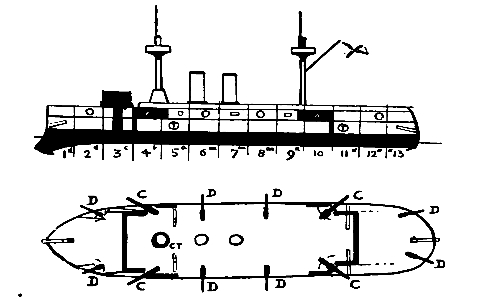
Diagram on Brasseys 1889
They were the first Russian capital ships with compound steel armor throughout.
Main waterline belt: 14 inches (356 mm) abreast the machinery spaces; 8 ft 6 in (2.59 m) high total, incl. 3 ft 6 in (1.07 m) above waterline, 2 feet (0.6 m) real.
Lower belt: 8 inches (203 mm) lower edge, thinned in stages.
Outer belt: 12 in thick abreast magazines, 3.9 inches (99 mm) bow, 4.9 inches (124 mm) stern, backed by 10 in (254 mm) wood.
Imperator Nikolai I had a 8 feet (2 m) high belt, 3 ft (0.91 m) above waterline, 5 feet (1.5 m) below. Bow and stern 6-in thick.
Flat protective deck: Connected to the upper edge of the belt, 2.5 inches (64 mm) thick (2x 1.25 inches or 32 mm layers of mild steel).
Main Barbette: front and sides 10 inches (254 mm), roof was 2½ inches.
Barbette cover: 3-inch (76 mm) protective hood (added late 1893).
Transverse bulkheads: 6 in thick
Main guns side plating: 3 inches thick
6-inch guns casemates: 2 inches (51 mm) thick.
No side armor above the main belt, added after the main guns mounts and pear-shaped barbette deleted to save weight.
No partitions between casemated guns, or between guns.
Conning tower: 8-inch (203 mm) sides Imperator Aleksandr II, 6 inches Imperator Nikolai I. Both: 2½-inch thick roof.
Powerplant
The Imperator Aleksandr II-class were supposed to reach a certain speed to achieve momentum in ramming and thus, they had two 3-cylinder vertical compound steam engines able to drive a 17-foot (5.2 m) screw propeller each. They were fed by twelve cylindrical boilers. Imperator Aleksandr II had Baltic Works engines, which designed output was 8,500 ihp (6,338 kW) and on trials from an output of 8,289 ihp (6,181 kW) she reached 15.27 knots (28.28 km/h; 17.57 mph). With 967 long tons (983 t) of coal she was able to reach 4,400 nautical miles (8,100 km) at 8 knots (15 km/h; 9.2 mph), down to 770 nautical miles (3,280 km) at 15 knots (28 km/h; 17 mph) top speed. Rigging was envuisioned in 1886 but never installed. Instead they were completed with military masts with fighting tops but still had potential for rigging.
Imperator Nikolai I differed by her engines made at Franco-Russian Works, with a lower output of 8,000 ihp (5,966 kW) on paper but she proved a failure on trials, only making 7,842 ihp (5,848 kW), for 14.5 knots (26.9 km/h; 16.7 mph). She carried the same amount of coal but for 2,630 nautical miles (4,870 km) at 10 knots (19 km/h; 12 mph).
Armament
Main Armament: 2x 305 mm/35 M1877

Nikolai I turret.
Both battleships had a pair of 12-inch (305 mm) Obukhov Model 1877 30-caliber guns forward. However those in Imperator Aleksandr II had a twin barbette mount forward, Imperator Nikolai I ones were inside a turret. Specs:
-Maximum elevation was 15°, depression 2°, traverse 220°.
-60 rounds were provided per gun.
-Shell: 731.3-pound (331.7 kg) mv 1,870 ft/s (570 m/s) Range 5,570 yards (5,090 m) at 6°.
-Rate of fire: One round every 4-5 minutes.
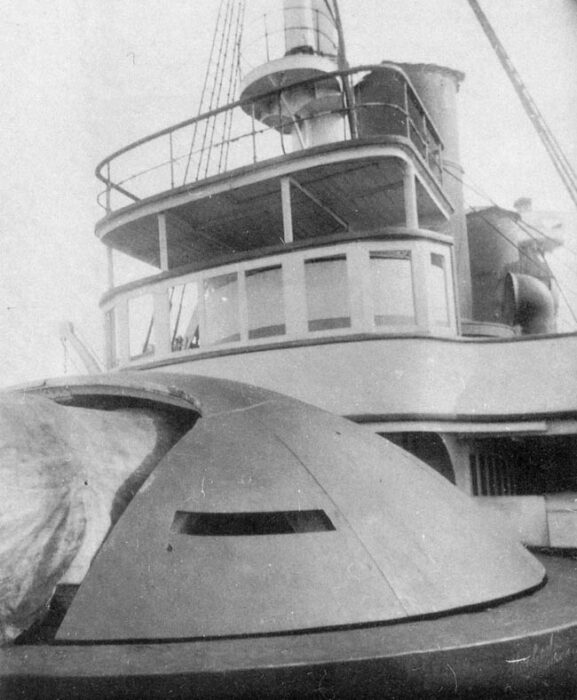
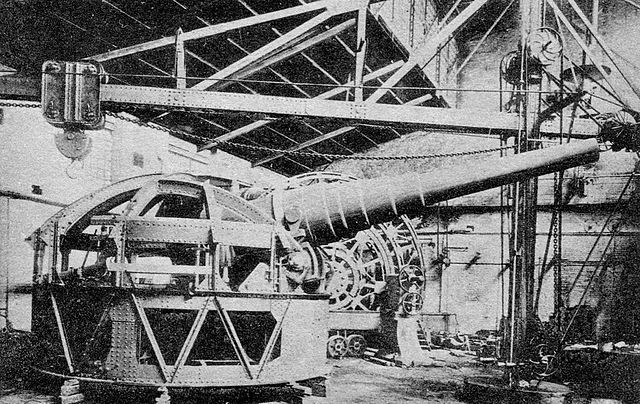
Alxander II barbette in construction and in place
9-inch/35 (229 mm) Obukhov M1877
The secondary guns were four 9-inch (229 mm) Obukhov Model 1877 35-caliber were placed in center-pivot mounts, in casemates at the corners of the citadel emerging from hull recesses for a better arc of fire.
Traverse: Forward guns 125°, 4° centerline. Rear guns 105°, +10° centerline.
Maximum elevation: 15°, depression 5°.
Provision: 125 rounds per gun
Sheels: Light 277–280 lb (126–127 kg); heavy 415 lb (188 kg).
Muzzle velocity: Light 2,142 ft/s (653 m/s), +smokeless powder 2,326 ft/s (709 m/s). Heavy brown powder 1,867 ft/s (569 m/s).
Range: Light shell 10,330 yards (9,450 m)/15° smokeless powder.
Rate of fire: One round every minute, best.
6-in/35 M1877
The eight 6-inch (152 mm) Model 1877 35-caliber guns were placed in broadside pivot mounts, with four traversing a total of 100° and the others at each end to fire ahead or astern. Each had an arc of fire of 130°.
Elevation: 12°, depression 8°.
Shells:
-Heavy type 119–123.5 lb (54.0–56.0 kg), muzle velocity 1,896 ft/s (578 m/s)
-Light 91.5 lb (41.5 kg), muzzle velocity of 2,329 ft/s (710 m/s).
Maximum range: Light8,170 yards (7,470 m) at 12°. Rate of fire one round per minute.
Light artillery: 47 mm Hotchkiss
The ten 47-millimeter (1.9 in) Hotchkiss revolving cannon were mounted in hull embrasures alternating between the 9 and 6-inch to deal with torpedo boats.
Shell: 3.3-pound (1.5 kg) shell at 1,476 ft/s (450 m/s) at 30 rounds per minute and up to 2,020 yards (1,850 m).
There were then four 37-millimeter (1.5 in) Hotchkiss revolving cannon, mounted in the two fighting top, with two embrasures each. They fired a 1.1-pound (0.50 kg) shell at 1,450 ft/s (440 m/s) at and at 32 rounds per minute up to 3,038 yards (2,778 m).
Torpedo tubes
Customary of the time, both battleships carried five above-water 15-inch (381 mm) torpedo tubes: Two in the bow, Two broadside, traversing 70°, and one in the stern.
Imperator Nikolai I had six insteads, one in the bow, four broadside (forward and aft) and stern. Whitehead Kark I or Schwartzkopf models.
Smaller 14-inch (356 mm) torpedo tubes could be mounted in four on the steam cutters on board boith for offensive actions in enemy harbours and protect a perimeter when at anchor.
Mines
36 mines could be carried. See the post on WWI russian minelayers for more.
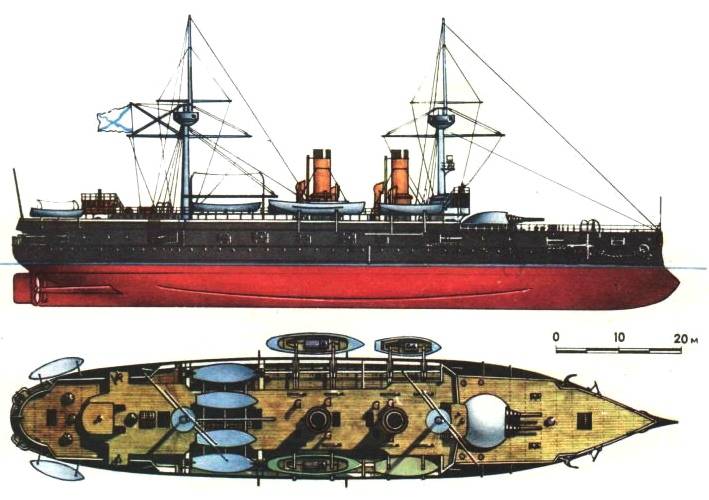
Aleksandr II as completed from an old Russian publication (src topwar.ru)
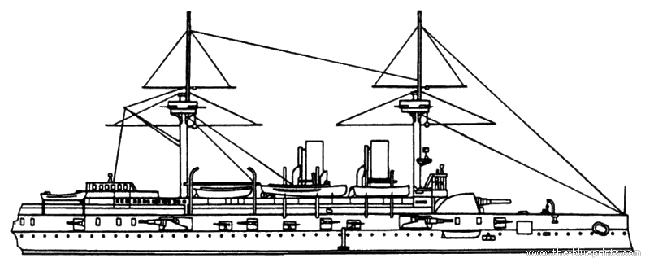
Conway’s depiction of Alexander II
⚙ specifications (Imp. Aleksandr) |
|
| Displacement | 9,244 long tons (9,392 t) |
| Dimensions | 346 ft 6 in x 66 ft 11 in x 25 ft 9 in (105.61 x 20.40 x 7.85 m) |
| Propulsion | 2 shafts, 2 compound steam engines, 12x cylindrical boilers 8,289 ihp (6,181 kW)* |
| Speed | 15.27 knots (28.28 km/h; 17.57 mph) |
| Range | 4,440 nmi (8,220 km; 5,110 mi) at 8 knots (15 km/h; 9.2 mph) |
| Armament | 2x 305 mm, 4× 229 mm, 8× 152 mm, 10× 47 mm Hotchkiss, 10× 37 mm Hotchkiss, 5× 381 mm TTs |
| Protection | Belt 102–356 mm, Deck 64 mm, Barbette 254 mm, hood 76 mm, see notes |
| Crew | 616 |
Career of the Imperator Aleksandr II class Battleships:
 Imperator Aleksandr II (1887)
Imperator Aleksandr II (1887)
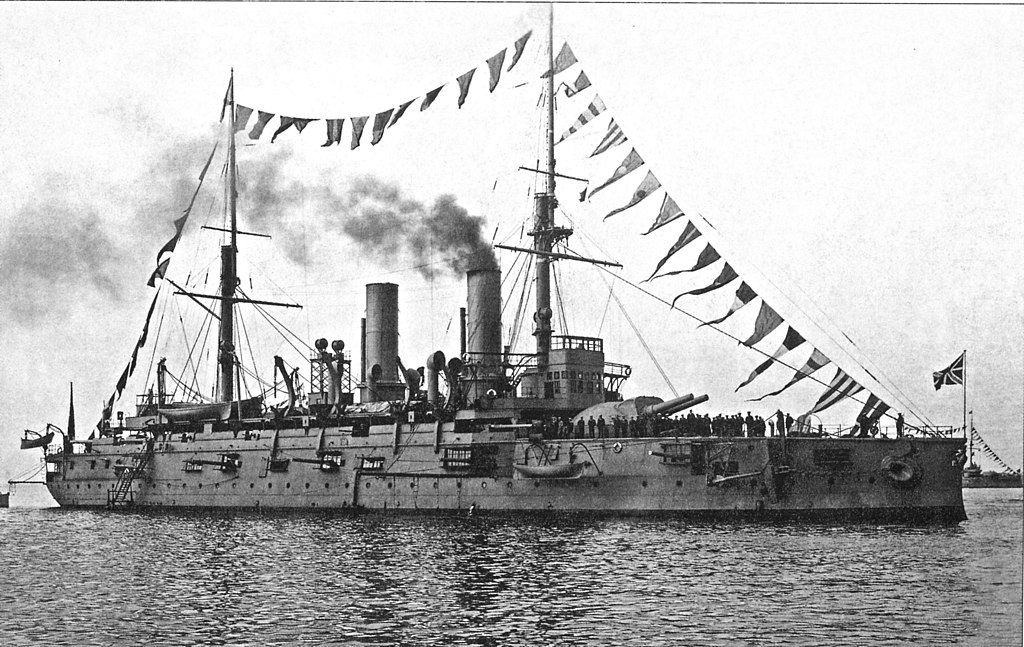
Aleksandr II at Reval in 1913
Imperator Aleksandr II was laid down at New Admiralty Yard, in Saint Petersburg on 12 July 1885, launched on 13 July 1887 and commissioned on June 1891. She served in the Baltic Fleet and sailed with the cruiser Rurik to represent Russia for the opening of the Kiel Canal by June 1895. She ran aground in Vyborg with little damage. She joined the Mediterranean Squadron in August 1896 and was deployed to Crete in February 1897 with the International Squadron, to foil the Greek uprising against the Ottoman Empire. On 21 February 1897, she joined HMS Revenge and torpedo HMS Dryad, HMS Harrier for her first direct offensive action, bombardment of Cretan insurgent positions on Canea (Chania) after they refused to take down a Greek flag just raised.
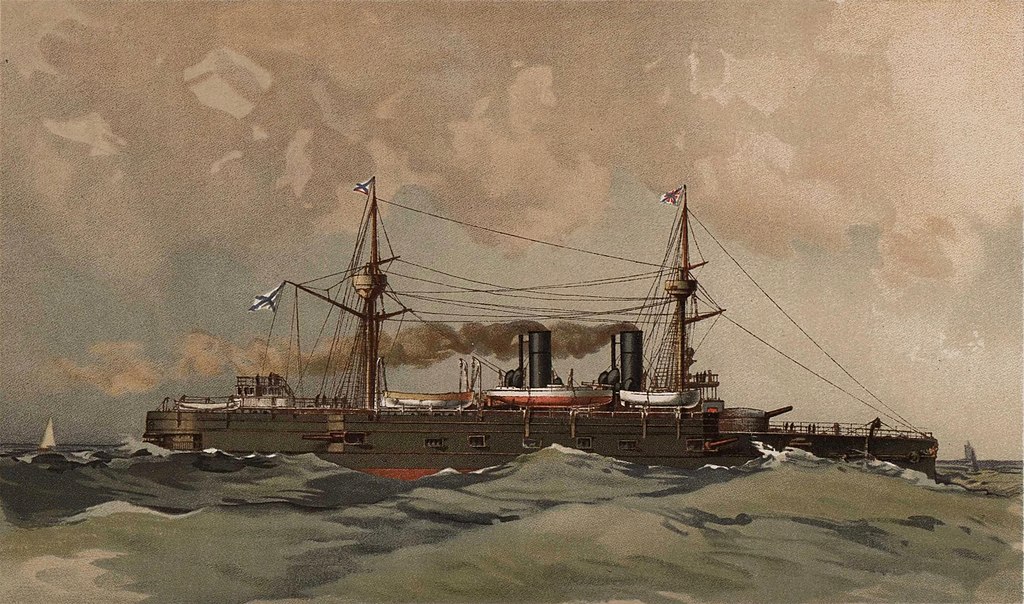
Aleksandr II painting as completed
Imperator Aleksandr II was refitted in Kronstadt from September 1901, reboilered December 1903 modified in 1904 as artillery school ship. Conway’s take on her, was that she was reconstructed in France between 1902 and 1904, torpedo tubes removed, 6/9-inch guns exchanged for five 8-inch (200 mm)/45, eight 6-inch/45 guns, ten 3-pounder guns installed. Arbazov confirms the torpedo tubes removed and 9-inch guns replaced by five 8-in with a 5th at the stern, and new 6-inch guns, 4x 47-mm and 4x 120-mm guns added on the upper deck.
Her crew supported the mutinous garrison of Fort Konstantin in August 1906. She was assigned to the Artillery Training Detachment in 1907 and in World War I remained anchored in Kronstadt, he crew soon turning to the revolutionary movement. She was renamed Zarya Svobody in May 1917, turned over to the Kronstadt port authority on 21 April 1921 but sold for scrap on 22 August 1922, towed to Germany for BU and not stricken before 21 November 1925.
 Imperator Nikolai I (1889)
Imperator Nikolai I (1889)
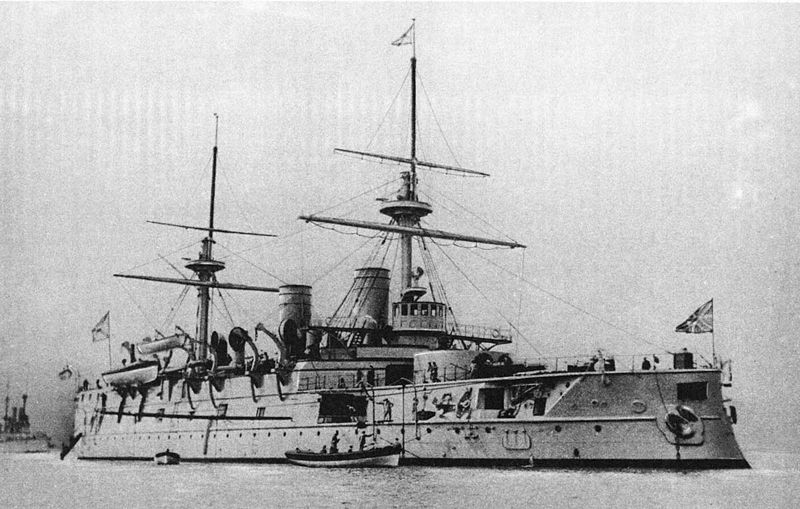
Nikolai I in the early 1900s.
Imperator Nikolai I was ordered to the Franco-Russian Works at Saint Petersburg on 1 January 188, laid down on 4 August 1886, launched on 1 June 1889 and commissioned on July 1891 with her trials lasting until the spring of 1892. In June 1892 she left for New York City, participating in the celebration 400th anniversary of the discovery of America. Next she was assigned to the Mediterranean Squadron, visited Toulon in October 1893 with the Russian Squadron as part of the Franco-Russian Alliance. Under Captain Richard Dicker she was sent to the Pacific to witness the First Sino-Japanese War. She arrived at Nagasaki on 28 April 1895, and sailed for Chefoo, China. by late 1896 she returned to the Mediterranean Squadron and Black sea fleet.
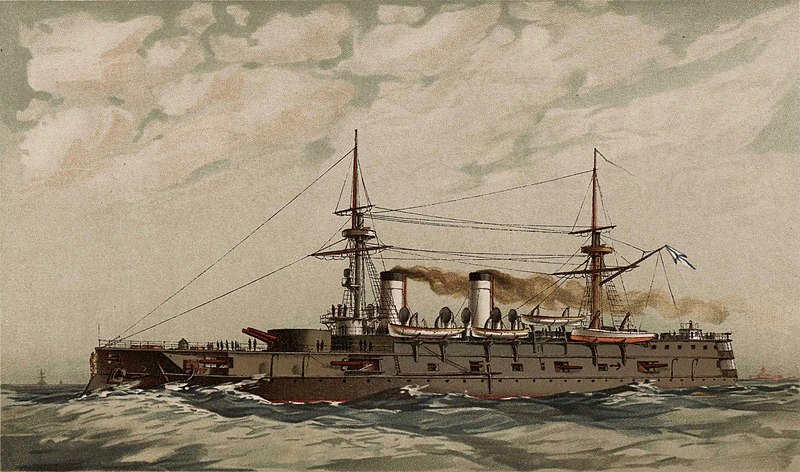
Nikolai I painting in 1892
She took part in the International Squadron which intervened in the 1897–1898 Greek Christian uprising against the Ottoman Empire in Crete. On 14 February 1897 she hosted the Ottoman governorGeorge Berovich before her fled to Trieste on an Austrian steamer. She was back to the Baltic in April 1898 for a long refit, with with Belleville water-tube boilers installed plus new vertical triple expansion steam engines. Her after superstructure was cut down a deck high abaft the mainmast, her 47 mm and 37 mm guns removed. Two 37 mm revolvers were retained and instead she had new 47 mm and two 37 mm single-barreled guns.
Imperator Nikolai I was back in the Mediterranean by September 1901 until the Russo-Japanese War broke out. She was transferred to the Baltic to be refitted by late 1904 and became flagship of the Third Pacific Squadron (Rear Admiral Nikolai Nebogatov) ordered to depart Liepāja on 15 January 1905. She took part in the Battle of Tsushima, and received a single 12-inch hit, two 8-inch, two 6-inch hits with 5 killed and 35 wounded. But under orders and too slow to escape she was surrendered, like the third of the Pacific Squadron by Admiral Nebogatov.
On 6 June 1905, she was integrated into the Imperial Japanese Navy as IJN Iki (after Iki Island, Sea of Japan) and used as a gunnery training ship until 12 December 1910. She then became a 1st-class coast defense ship and TS, keeping her main gun turret, but had new6-in/40 caliber Armstrong Pattern Z guns, single mounts, six 4.7-inch/40 caliber Armstrong Pattern T, single mounts, and six 3-inch/40 caliber Armstrong N; single mounts, as her six original 18-inch torpedo tubes. She was stricken 1 May 1915, sunk as a target on 3 October 1915 by IJN Kongō and Hiei (Watts and Gordon: scrapped in 1922).
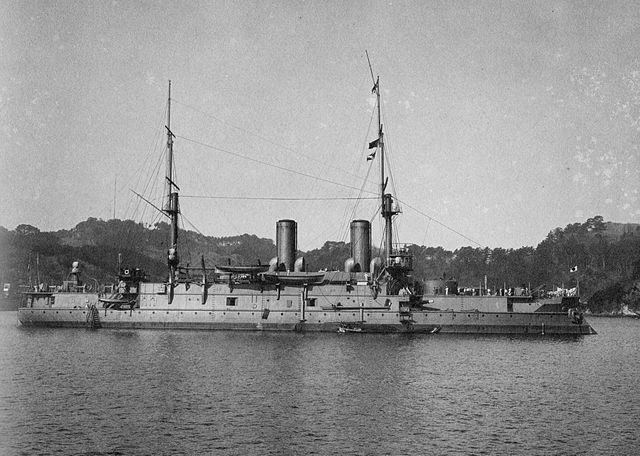
IJN Iki in Yokosuka 1906
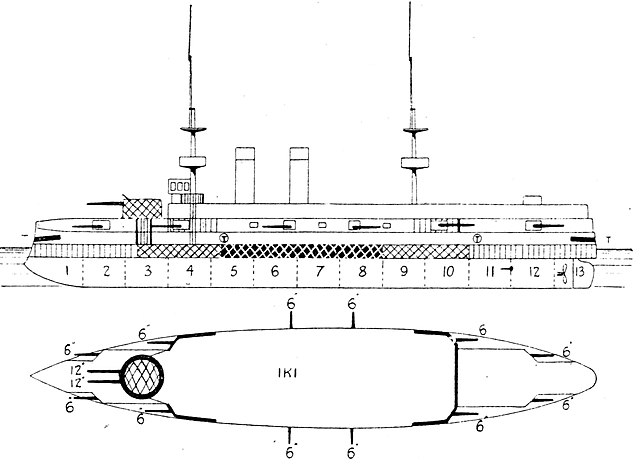
IJN Iki scheme and elevation plan, Brasseys 1907
Read More/Src

Shipyard Model, pinterest. More views (on sale)
From ship.bsu.by (archive)
Emperor Alexander II Series
The Emperor Alexander II class of ships inherited the artillery layout, powerful ram stem, relatively weak protection of the stern and medium-caliber artillery from the British Conqueror-Victoria family of ships. However, it had a number of advantages: a full armor belt along the waterline, high sides, which significantly improved seaworthiness and allowed firing in fresh weather, increased firing angles of medium-caliber guns. The main caliber artillery on the Emperor Alexander II was placed in the bow barbette – like the first Black Sea battleships of the Ekaterina II class, and on the second ship of the same type, the Emperor Nikolai I, – in a two-gun turret designed by the shipbuilding engineer N. E. Kuteinikov. In the bow section, the Emperor Alexander II was the only battleship in the Russian fleet to have two symmetrically mounted torpedo tubes (instead of the traditional single stem): it was believed that this would not weaken the main weapon, the ram. It is noteworthy that the new Baltic battleships were entirely built at domestic enterprises. The subcontractors of the St. Petersburg shipyards were the Obukhov (artillery), Metallichesky (torpedo tubes), Baltic and Franco-Russian (machinery and mechanisms), Izhora (armor) and many other plants.
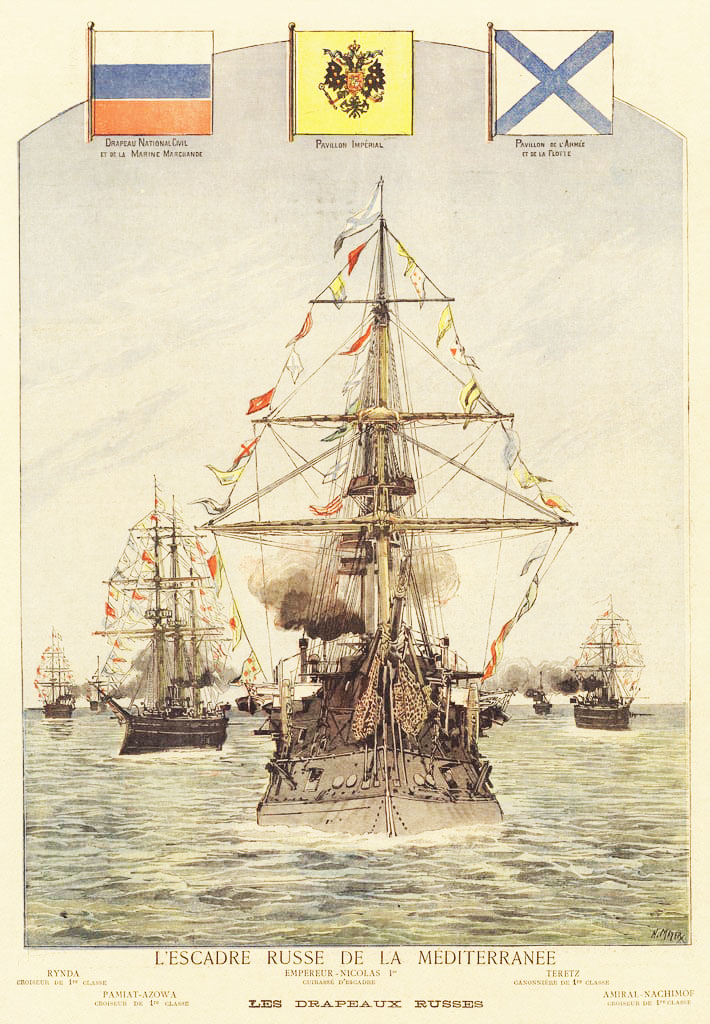
The Russian Sqn in the Mediterranean, Heni Meyer
In June 1895, she participated in the opening ceremony of the Kiel Canal. Major repairs in 1904-1905. New boilers were installed on the battleship, the combat topsails were removed, and the masts were reduced. Participated in the First World War (used to train naval artillery specialists), the February Revolution, the October armed uprising in Petrograd and the civil war (suppression of the Kerensky-Krasnov mutiny from November 9 to 12, 1917).
On November 8, 1917, it became part of the Red Baltic Fleet and on April 21, 1921, it became part of the Baltic Sea naval forces. From May 21, 1921, it was stored in the Kronstadt military port.
On August 15, 1922, it was sold to the joint Soviet-German joint-stock company “Derumetall” for dismantling, in the fall of 1922 it was towed to Germany for scrapping and on November 21, 1925, it was excluded from the list of ships of the Red Navy. Emperor Nicholas I 1891/1915
“Emperor Nicholas I” spent most of its service under the St. Andrew’s flag on foreign voyages. In 1893, it crossed the Atlantic and took part in the celebrations of the 400th anniversary of the discovery of America, which took place in New York. Then – the Mediterranean Sea, from there – a passage under the flag of Rear Admiral Makarov to the Far East. After a short stay in the Baltic – another trip to the Pacific Ocean, this time as part of the squadrons of Vice Admiral Z. P. Rozhestvensky. On the second day of the battle with the Japanese fleet in the Tsushima Strait, Rear Admiral N. I. Nebogatov, who held the flag on the “Emperor Nicholas I”, surrendered the remains of the fleet to the enemy. Upon returning from Japanese captivity, Nebogatov was put on trial…
In the Japanese fleet, the battleship, renamed “Iki”, was listed as a training ship. In 1915, it became a floating target and was soon sunk by the artillery of the newest battlecruisers Kongo and Hiei.
Gallery
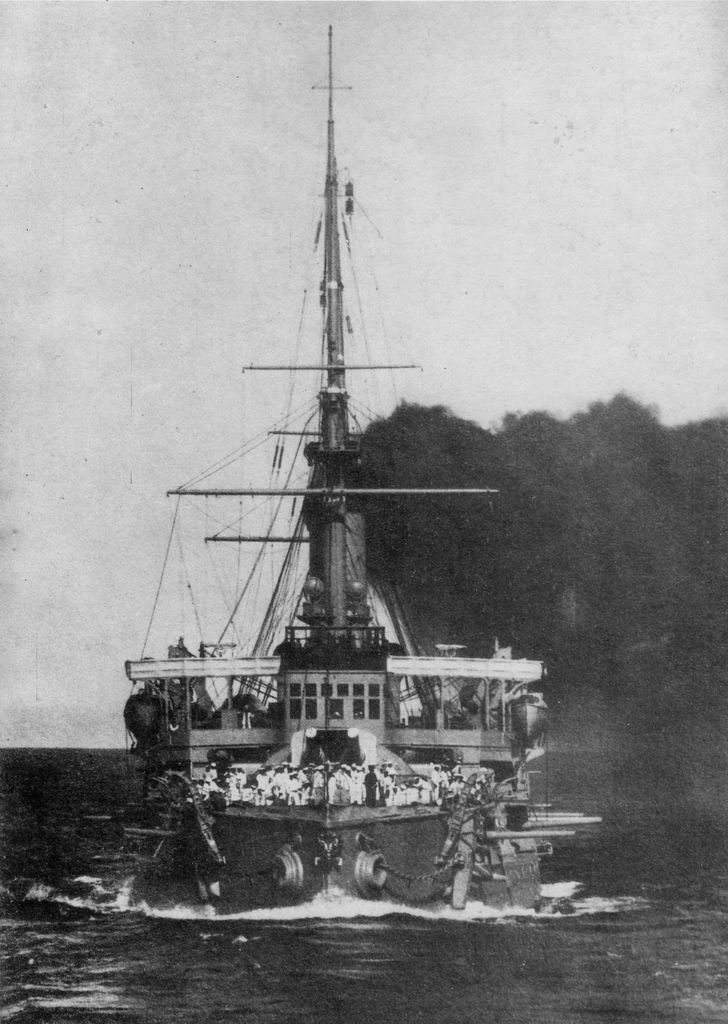
Books
Arbuzov, V. V. (1997). Bronenoset︠s︡ Imperator Aleksandr II. Bronenost︠s︡y russkogo flota (in Russian). Vol. 4.
Gardiner, Robert, ed. (1979). Conway’s All the World’s Fighting Ships 1860–1905.
McTiernan, Mick, A Very Bad Place Indeed For a Soldier. The British involvement in the early stages of the European Intervention in Crete.
McLaughlin, Stephen (2003). Russian & Soviet Battleships. NIP
А.Б. Широкорад. Корабельная артиллерия российского флота 1867–1922 г. «Морская коллекция» No. 2 за 1997 год.
Моисеев С. П. Список кораблей русского парового и броненосного флота 1861–1917 г. М., Воениздат, 1948
Чертеж ЭБР «Император Николай I». Тверь, «Ретро-Флот», 1993
Вторая тихоокеанская эскадра. «Наваль», вып. 1, с. 24–29. М., 1991
А.А. Белов «Броненосцы Японии». Серия “Боевые корабли мира”
Links
on ru.wikipedia.org
http://armoured.ru
http://armoured.ru/imperator_aleksandr_vtoroy.
mmt.ru/
razlib.ru/
battleships.spb.ru
morbox.ru/ bronenosec-aleksandr-ii.html
en.wikipedia.org/
http://ship.bsu.by
en.topwar.ru



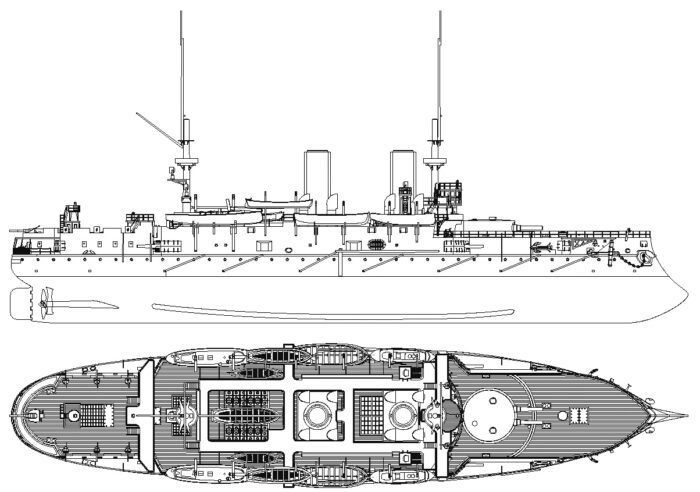
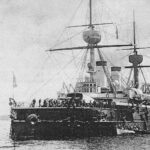
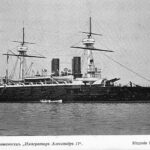
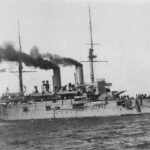
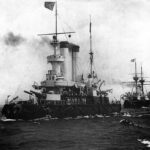
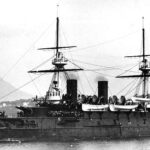
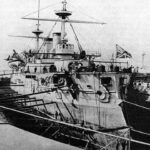
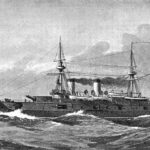
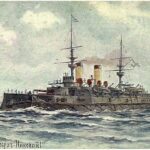
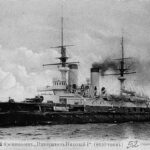
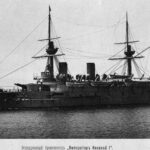
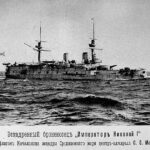
 Latest Facebook Entry -
Latest Facebook Entry -  X(Tweeter) Naval Encyclopedia's deck archive
X(Tweeter) Naval Encyclopedia's deck archive Instagram (@navalencyc)
Instagram (@navalencyc)





 French Navy
French Navy Royal Navy
Royal Navy Russian Navy
Russian Navy Armada Espanola
Armada Espanola Austrian Navy
Austrian Navy K.u.K. Kriegsmarine
K.u.K. Kriegsmarine Dansk Marine
Dansk Marine Nautiko Hellenon
Nautiko Hellenon Koninklije Marine 1870
Koninklije Marine 1870 Marinha do Brasil
Marinha do Brasil Osmanlı Donanması
Osmanlı Donanması Marina Do Peru
Marina Do Peru Marinha do Portugal
Marinha do Portugal Regia Marina 1870
Regia Marina 1870 Nihhon Kaigun 1870
Nihhon Kaigun 1870 Preußische Marine 1870
Preußische Marine 1870 Russkiy Flot 1870
Russkiy Flot 1870 Svenska marinen
Svenska marinen Søværnet
Søværnet Union Navy
Union Navy Confederate Navy
Confederate Navy Armada de Argentina
Armada de Argentina Imperial Chinese Navy
Imperial Chinese Navy Marinha do Portugal
Marinha do Portugal Mexico
Mexico Kaiserliche Marine
Kaiserliche Marine 1898 US Navy
1898 US Navy Sovietskiy Flot
Sovietskiy Flot Royal Canadian Navy
Royal Canadian Navy Royal Australian Navy
Royal Australian Navy RNZN Fleet
RNZN Fleet Chinese Navy 1937
Chinese Navy 1937 Kriegsmarine
Kriegsmarine Chilean Navy
Chilean Navy Danish Navy
Danish Navy Finnish Navy
Finnish Navy Hellenic Navy
Hellenic Navy Polish Navy
Polish Navy Romanian Navy
Romanian Navy Turkish Navy
Turkish Navy Royal Yugoslav Navy
Royal Yugoslav Navy Royal Thai Navy
Royal Thai Navy Minor Navies
Minor Navies Albania
Albania Austria
Austria Belgium
Belgium Columbia
Columbia Costa Rica
Costa Rica Cuba
Cuba Czechoslovakia
Czechoslovakia Dominican Republic
Dominican Republic Haiti
Haiti Hungary
Hungary Honduras
Honduras Estonia
Estonia Iceland
Iceland Eire
Eire Equador
Equador Iran
Iran Iraq
Iraq Latvia
Latvia Liberia
Liberia Lithuania
Lithuania Mandchukuo
Mandchukuo Morocco
Morocco Nicaragua
Nicaragua Persia
Persia San Salvador
San Salvador Sarawak
Sarawak Uruguay
Uruguay Venezuela
Venezuela Zanzibar
Zanzibar Warsaw Pact Navies
Warsaw Pact Navies Bulgaria
Bulgaria Hungary
Hungary

 Bundesmarine
Bundesmarine Dutch Navy
Dutch Navy Hellenic Navy
Hellenic Navy Marina Militare
Marina Militare Yugoslav Navy
Yugoslav Navy Chinese Navy
Chinese Navy Indian Navy
Indian Navy Indonesian Navy
Indonesian Navy JMSDF
JMSDF North Korean Navy
North Korean Navy Pakistani Navy
Pakistani Navy Philippines Navy
Philippines Navy ROKN
ROKN Rep. of Singapore Navy
Rep. of Singapore Navy Taiwanese Navy
Taiwanese Navy IDF Navy
IDF Navy Saudi Navy
Saudi Navy Royal New Zealand Navy
Royal New Zealand Navy Egyptian Navy
Egyptian Navy South African Navy
South African Navy






























 Ukrainian Navy
Ukrainian Navy dbodesign
dbodesign